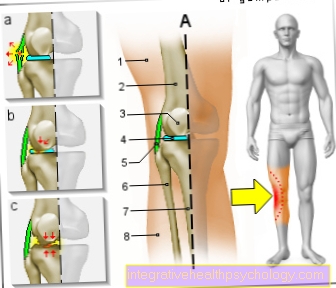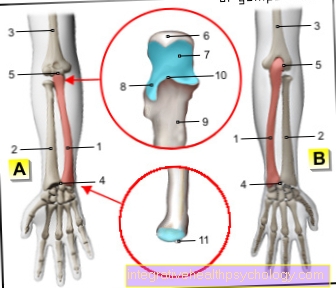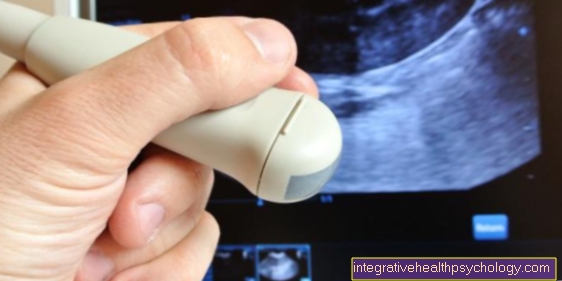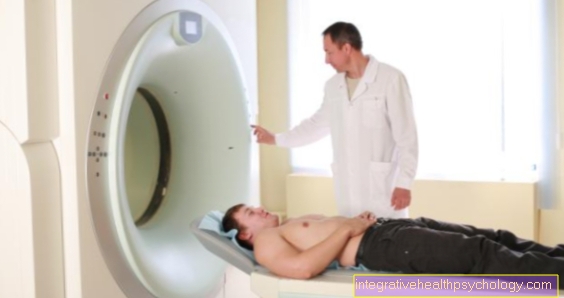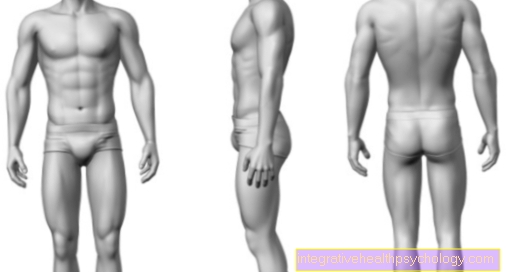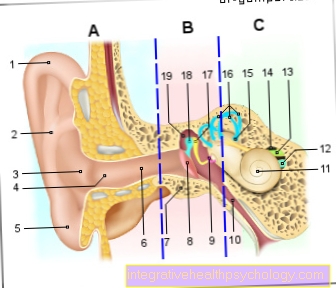Trigonum femoral
introduction
The trigonum femorale, also known as Scarpa triangle or thigh triangle, describes a triangular area on the inside of the thigh, the tip of which points downwards towards the knee. It is a visible indentation on the inside of the thigh that is just below the groin. The femoral trigonum is an important anatomical region. The large leg vessels (arteria femoralis, vena femoralis) and the nerves supplying the legs (nervus femoralis and saphenous nerve) run through the thigh triangle.

anatomy
The femoral trigonum lies below the groin and is a visible indentation on the inside of the thigh. The roof of the femoral triangle forms the Inguinal ligamentto form the bottom of the Muscle iliopsoas, as well as the Pectineus muscle. The outer limit is formed by the Sartorius muscle. The femoral trigonum is drawn inwards through the Adductor longus muscle limited. Vital vascular-nerve routes run in the femoral trigonum. So it contains the great leg artery (Femoral artery) with their outgoing branches that great leg vein (Vena femoralis), as well as several nerves (Femoral nerve, Saphenous nerve), which innervate the leg muscles motor and the skin of the leg sensitively. It also contains several large lymph node stations. The trigonum femorale is also called "Scarpa triangle“Labeled, after Antonio Scarpa, an eminent Italian anatomist who lived in the 18th and 19th centuries.
Trigonum laterale
The anterior femoral region is to be distinguished from the medial femoral trigonum. It lies laterally (i.e. outside, to the side) of the femoral triangle and encompasses the front of the thigh. It is made of Quadriceps femoris muscle and is inwardly through the Sartorius muscle delimited from the femoral trigonum.
Lymph nodes
The inguinal lymph nodes, also known as inguinal lymph nodes, are located at the upper base of the femoral triangle.They are further subdivided into the superficial and the deep inguinal lymph nodes. The deep inguinal lymph nodes also include the Rosenmüller lymph node, which is located in the lacuna vasorum. The lymph nodes in the groin get their lymph fluid mainly from the legs, the external genitals, the buttocks and the abdominal wall below the navel. Inflammation or tumors in the above-mentioned drainage areas can lead to thickening and palpable enlargement of the lymph nodes, which should be clarified by a doctor.
Read more on this topic at: Lymph node swelling in the groin
Saphenous hiatus
The saphenous hiatus (Latin: "hidden slit") is located in the femoral trigonum and describes an opening on the medial edge of the fascia lata. In the hiatus saphenus the Femoral artery in its 3 superficial and one deep branch. The superficial arteries: Superficial epigastric artery, External pudendal artery and the Arteria circumflexa ilium superficialis run through the saphenous hiatus. Furthermore, the "Venous star". The smaller superficial veins and the Great saphenous vein into the deep femoral vein. In addition, the hiatus saphenus also represents the outer hernial port of a Femoral hernia represent.
Gracilis muscle
The Gracilis muscle, also known as the "lean muscle" or the "virgin guardian", is a thin, superficial thigh muscle that is one of the adductors. It lies on the inside of the thigh and has its origin on Pubic bone (Os pubis) and on the lower edge of the Symphysis. From there he moves to the Shinwhere it works together with the tendons of the Sartorius muscle and des Semitendinosus muscle his common approach (Pes anserinus superficialis) Has. The gracilis muscle is innervated by the Obturator nerve. Its function is adduction (drawing the leg towards the body) and flexion in the hip, as well as internal rotation and flexion in the knee.




